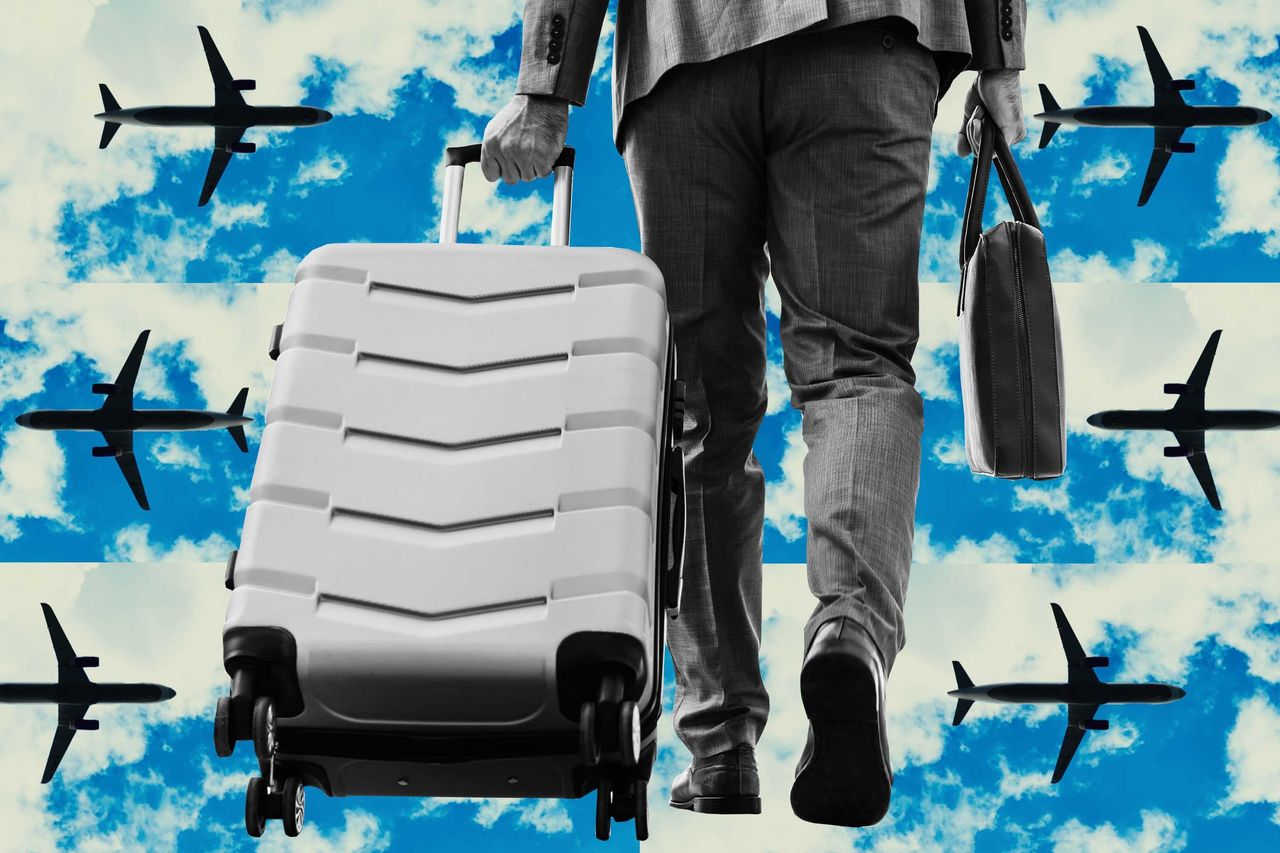I’m a Supercommuter. Here’s What It’s Really Like.
The money, miles and stamina it takes to work in New York and live in Columbus, Ohio
Sometimes I sleep in a different New York City hotel room every night.
On a recent Monday, it was a Midtown Manhattan Hampton Inn. The next night, a budget hotel downtown. Then I moved to a Hyatt in Queens, near John F. Kennedy International Airport, where I waited to check in behind a group of pilots and flight attendants.
The reason for this madness: My job is in New York, but my apartment is in Columbus, Ohio. When hotel prices are high, I property-surf to find a lower rate.
For more than a year, to the bafflement of family, friends and colleagues, I have attempted to live and work as a supercommuter. What began as a postpandemic experiment of flying to and from New York each week has turned into what I am hesitant to call a lifestyle.
Like many, I moved out of the city early in the pandemic, relocating near family in the Midwest. When it came time to return in 2022, I was underwhelmed at the housing options in my price range. I toured one-room studios facing brick walls and climbed crumbling staircases to reach dank apartments with ancient fixtures. I also had grown accustomed to midweek evening walks with my sister in Ohio, and a short drive to see my parents. I didn’t want to fully give that up.
Using back-of-the-envelope math, I thought I could keep my expenses—rent in Ohio, plus travel costs—at or below the price of a nice New York studio, or roughly $3,200 a month. The Wall Street Journal requires office attendance at least three days a week and, since I commute by choice, I pay all my travel expenses.
Luxury suites and room service
The challenge felt oddly thrilling. If anybody could find a way to subvert high New York real-estate costs, while remaining close to family, I thought it might be me. For years, I’ve been an on-call travel guru to friends and co-workers, coaching people on how to navigate flight cancellations and play the credit-card bonus games. I memorise aircraft configurations and spend hours reading mileage blogs and industry sites like Airliners.net.
Before mileage runs became useless, I obsessed over reaching top-tier airline status by spending as little as possible. (Family members still roll their eyes at the six hours I spent in Anchorage one December afternoon to requalify for Delta’s Diamond tier.) When a flight is oversold, I am quick to volunteer my seat in exchange for a voucher. (My best-ever haul: $2,000 after giving up my seat on multiple oversold flights one Saturday in San Francisco.)
Nerding out about this stuff has allowed me to travel farther and in more rarefied air than I could otherwise afford.
Entering my supercommuter era, I had visions of flying to New York on a weekday morning (8,500 points one way on American Airlines), spending the day meeting sources and filing stories, and retiring to one of my favourite points hotels—the Beekman. Mornings would begin with a free breakfast thanks to my Hyatt status, before a short subway ride to the office. After two nights, I’d return to Columbus and my roomy apartment, half the price of a Manhattan studio.
Shocking no one, that fantasy soon came crashing down.
Burning points on fancy hotel rooms was the first problem. The life of a journalist is hard to predict. I repeatedly found myself on deadline and having to rebook flights or stay an extra night, costing me money or miles.
Once I was back in the city, it also got harder to say no. Stay an extra night to attend a friend’s birthday party or meet a CEO in town just for the day? Sign me up. I didn’t want my living situation to strain relationships or interfere with my job, which I love.
To conserve hotel points, I swapped the Beekman’s elegant rooms in lower Manhattan for a Hyatt attached to a casino in Jamaica, Queens. My rooms overlooked a sea of empty parking spaces, but required half as many points as Manhattan alternatives.
Flight delays and blown budgets
By summer, with my miles dwindling and New York hotel rates rising, I reluctantly began to rely on the kindness of those around me. Hearing I might need a place, one friend mailed me the keys to her family’s unoccupied apartment in New Jersey. Another let me stay in her smartly designed Brooklyn one-bedroom for weeks as she traveled. A cherished deskmate, known for her tell-it-like-it-is demeanour, repeatedly offered a bedroom in her Chelsea loft, handing over the keys with a sometimes expletive-tinged reminder to: “Get a f—ing apartment.”
I watered plants, walked friends’ dogs and fed their cats while they were away. Still, working in a city without a permanent home took a toll. I came to dread the go-to question asked at parties and work events in New York: “So where do you live?”

CHIP CUTTER/THE WALL STREET JOURNAL
If I admitted, “it’s kind of complicated,” I got sucked into explaining my life as a supercommuter. Sometimes, I’d just tell people the location of that evening’s hotel. (Chelsea!)
Costs mounted in the fall, New York’s prime tourist and business-travel season. Friends teased me for embracing a life of chaos. They weren’t wrong. Without a refrigerator or stove, late-night dinners often consisted of yogurt and fruit purchased from a 24-hour CVS. Needing to pack light, I stored shoes under my desk and left spare outfits on an office coat rack.
To get to the office on time, I set my alarm in Columbus for 4:15 a.m. and hustled to the airport for 6 a.m. flights. When everything went according to plan, I made it door-to-door in three hours. If delays occurred, I scrambled to rebook on other flights.
My obsessive tracking of New York hotel prices taught me that dynamic pricing isn’t reserved for airlines. Hotel costs can fluctuate half a dozen times on the check-in date, so instead of booking in advance, I’d wait to pull the trigger until 10 p.m. some days after the rates fell.
In the end, the math didn’t work. I blew my budget by 15% and drained my miles balance. But I flew so much and stayed in so many hotels that I kept my elite status with Hyatt and American.
I still enjoy having one foot in the Midwest and one on the East Coast, though I’m not sure how long I can keep it up. I’m writing this from Columbus, where I overlook a beautiful park outside my picture window. My lease is up, but hotel rates in Manhattan this winter have plunged now that the holidays are over. Maybe that New York apartment search can be put off a little longer.
 Copyright 2020, Dow Jones & Company, Inc. All Rights Reserved Worldwide. LEARN MORE
Copyright 2020, Dow Jones & Company, Inc. All Rights Reserved Worldwide. LEARN MORE
From office parties to NYE fireworks, here are the bottles that deserve pride of place in the ice bucket this season.
Pure Amazon has begun journeys deep into Peru’s Pacaya-Samiria National Reserve, combining contemporary design, Indigenous craftsmanship and intimate wildlife encounters in one of the richest ecosystems on Earth.
Selloff in bitcoin and other digital tokens hits crypto-treasury companies.
The hottest crypto trade has turned cold. Some investors are saying “told you so,” while others are doubling down.
It was the move to make for much of the year: Sell shares or borrow money, then plough the cash into bitcoin, ether and other cryptocurrencies. Investors bid up shares of these “crypto-treasury” companies, seeing them as a way to turbocharge wagers on the volatile crypto market.
Michael Saylor pioneered the move in 2020 when he transformed a tiny software company, then called MicroStrategy , into a bitcoin whale now known as Strategy. But with bitcoin and ether prices now tumbling, so are shares in Strategy and its copycats. Strategy was worth around $128 billion at its peak in July; it is now worth about $70 billion.
The selloff is hitting big-name investors, including Peter Thiel, the famed venture capitalist who has backed multiple crypto-treasury companies, as well as individuals who followed evangelists into these stocks.
Saylor, for his part, has remained characteristically bullish, taking to social media to declare that bitcoin is on sale. Sceptics have been anticipating the pullback, given that crypto treasuries often trade at a premium to the underlying value of the tokens they hold.
“The whole concept makes no sense to me. You are just paying $2 for a one-dollar bill,” said Brent Donnelly, president of Spectra Markets. “Eventually those premiums will compress.”
When they first appeared, crypto-treasury companies also gave institutional investors who previously couldn’t easily access crypto a way to invest. Crypto exchange-traded funds that became available over the past two years now offer the same solution.
BitMine Immersion Technologies , a big ether-treasury company backed by Thiel and run by veteran Wall Street strategist Tom Lee , is down more than 30% over the past month.
ETHZilla , which transformed itself from a biotech company to an ether treasury and counts Thiel as an investor, is down 23% in a month.
Crypto prices rallied for much of the year, driven by the crypto-friendly Trump administration. The frenzy around crypto treasuries further boosted token prices. But the bullish run abruptly ended on Oct. 10, when President Trump’s surprise tariff announcement against China triggered a selloff.
A record-long government shutdown and uncertainty surrounding Federal Reserve monetary policy also have weighed on prices.
Bitcoin prices have fallen 15% in the past month. Strategy is off 26% over that same period, while Matthew Tuttle’s related ETF—MSTU—which aims for a return that is twice that of Strategy, has fallen 50%.
“Digital asset treasury companies are basically leveraged crypto assets, so when crypto falls, they will fall more,” Tuttle said. “Bitcoin has shown that it’s not going anywhere and that you get rewarded for buying the dips.”
At least one big-name investor is adjusting his portfolio after the tumble of these shares. Jim Chanos , who closed his hedge funds in 2023 but still trades his own money and advises clients, had been shorting Strategy and buying bitcoin, arguing that it made little sense for investors to pay up for Saylor’s company when they can buy bitcoin on their own. On Friday, he told clients it was time to unwind that trade.
Crypto-treasury stocks remain overpriced, he said in an interview on Sunday, partly because their shares retain a higher value than the crypto these companies hold, but the levels are no longer exorbitant. “The thesis has largely played out,” he wrote to clients.
Many of the companies that raised cash to buy cryptocurrencies are unlikely to face short-term crises as long as their crypto holdings retain value. Some have raised so much money that they are still sitting on a lot of cash they can use to buy crypto at lower prices or even acquire rivals.
But companies facing losses will find it challenging to sell new shares to buy more cryptocurrencies, analysts say, potentially putting pressure on crypto prices while raising questions about the business models of these companies.
“A lot of them are stuck,” said Matt Cole, the chief executive officer of Strive, a bitcoin-treasury company. Strive raised money earlier this year to buy bitcoin at an average price more than 10% above its current level.
Strive’s shares have tumbled 28% in the past month. He said Strive is well-positioned to “ride out the volatility” because it recently raised money with preferred shares instead of debt.
Cole Grinde, a 29-year-old investor in Seattle, purchased about $100,000 worth of BitMine at about $45 a share when it started stockpiling ether earlier this year. He has lost about $10,000 on the investment so far.
Nonetheless, Grinde, a beverage-industry salesman, says he’s increasing his stake. He sells BitMine options to help offset losses. He attributes his conviction in the company to the growing popularity of the Ethereum blockchain—the network that issues the ether token—and Lee’s influence.
“I think his network and his pizzazz have helped the stock skyrocket since he took over,” he said of Lee, who spent 15 years at JPMorgan Chase, is a managing partner at Fundstrat Global Advisors and a frequent business-television commentator.
Micro-needling promises glow and firmness, but timing can make all the difference.
By improving sluggish performance or replacing a broken screen, you can make your old iPhone feel new agai
























